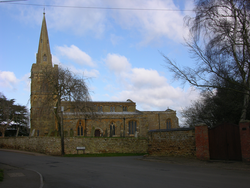
The Corpus of ROMANESQUE SCULPTURE in Britain & Ireland

Northamptonshire (now), "spratton"
Parish church
St Andrew's has an aisled and clerestoreyed nave with four-bay arcades; the N of the late 12thc., the S 13thc. with pointed arches and moulded capitals. The N and S doorways are 12thc., the N doorway under a porch. The aisle windows are renewed in an early 14thc. style. At the E end of the nave, above the chancel arch, is a large blocked window, apparently 14thc. The chancel has 14thc. sedilia. On the N side of the chancel, and separated from it by a two-bay arcade, is a chapel added by John Chambre between 1495 and 1505, now housing the organ and a vestry. This extends the N nave aisle as far as the E end of the chancel, but is screened from it. There is a 12thc. W tower with a contemporary tower arch. It is of three storeys; the lowest containing an elaborate W doorway and a blind arcade on the W face only, the next decorated with blind arcading, and the topmost with double bell-openings flanked by blind arches and a corbel table at the top. The belfry-stage lancets are Scott's replacements of Decorated windows (see Parker). It has a later recessed spire behind a battlemented parapet. The church was restored by Scott before 1849.
